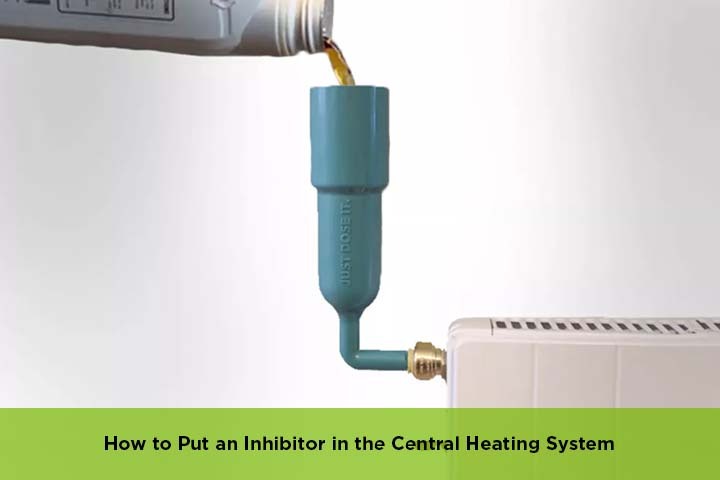Are you tired of cold spots in your radiators and sky-high energy bills? Well, grab a cuppa and get comfy, because we’re about to spill all the secrets about adding an inhibitor to your central heating system to sort out these issues yourself.
Whether you’re a DIY warrior or just someone who wants to keep their home cosy and efficient, this quick and easy guide is your ticket to heating system happiness.
What is an Inhibitor and Why Should You Add It to Your Central Heating System?
Your central heating system is like a tiny city of pipes and radiators, working hard to keep you warm. But just like any city needs protection, your heating system needs a superhero.
Enter the central heating inhibitor. This clever chemical compound is like a protective force field that wraps around every inch of your system.
But why should you add an inhibitor to your central heating?
- Without inhibitors, Your system becomes like a rusty old car, struggling to perform
- With inhibitors: It’s like giving your heating system a suit of armour.
Here’s what happens when you use an inhibitor in your system:
- Your radiators stay clean and efficient (goodbye, mysterious cold spots.)
- That fancy heated towel rail keeps working like a dream
- Your new boiler (or trusty old one) stays protected from the inside out
- The whole standard domestic system runs as smoothly as silk
Central heating inhibitor as your system’s personal bodyguard, fighting off:
- Nasty corrosion that loves to eat away at your pipes
- Stubborn sludge that makes your radiators less effective
- Inefficiencies that make your energy bills soar
- Problems that could lead to expensive repairs
The best part? Adding an inhibitor to your central heating is easier than you might think. It’s like giving your system a health boost that keeps working 24/7 to maintain optimal performance.
How Does a Chemical Inhibitor Prevent Radiator Sludge and Corrosion?
Now, let’s discuss how chemical inhibitors work. When you add chemical inhibitors to your heating system, it’s like sending an army of tiny shields throughout your pipes and radiators. This protective squad:
- Creates an invisible barrier that stops corrosion in its tracks
- Prevents sludge from setting up camp in your radiators
- Keeps water flowing as smoothly as a mountain stream
- Protects every metal surface it touches
The trick is to put an inhibitor into your central heating in just the right amount – not too much inhibitor (we’re not making soup here), and not too little. Think Goldilocks – it needs to be just right.
When Should You Drain and Add an Inhibitor to Your Central Heating System?
Timing is everything, folks. Just like you wouldn’t put on sunscreen after getting sunburned, you need to know the perfect moment to add an inhibitor to your central heating. Let’s break it down into bite-sized pieces:
Perfect Times to Take Action:
- Got a shiny new boiler? That’s your cue to add an inhibitor.
- Spring cleaning your system? Perfect time to drain and refresh
- Hearing your radiators making weird noises? Don’t wait.
- Notice your heated towel rail acting less than toasty? Time for action.
Before you add an inhibitor to your central, here’s a pro tip: drain some water from the system first. Think of it as giving your heating system a fresh start – out with the old sludge, in with the new protection.
Can You Bleed a Radiator After Adding an Inhibitor?
You bet your woolly socks you can. In fact, you absolutely should bleed a radiator after adding that protective goodness. Here’s why:
Think of your radiator as a balloon full of water and air:
- Air bubbles are like uninvited party guests – they need to go.
- When you bleed a radiator, you’re showing those air bubbles the door
- This helps your inhibitor reach every nook and cranny
The Bleeding Process Made Simple:
- Wait for your inhibitor to circulate
- Listen for gurgling (that’s your radiator telling you it needs bleeding.)
- Grab your radiator bleed valve key
- Get ready for some satisfying hissing sounds
- Hello, efficient heating.
How Do You Isolate, Clean, and Balance a Radiator for Inhibitor Efficiency?
Ready to become a radiator whisperer? Here’s your step-by-step guide to radiator perfection:
Step 1: Isolate a Radiator
- Think of this as putting your radiator in time-out.
- Turn off those valves (lefty-loosey, righty-tighty).
- Now you’ve got your own little workspace.
Step 2: Clean a Radiator
- Remove the gunk that’s been partying in there.
- Flush out all that unwanted sludge.
- Give it a proper power wash from the inside.
Step 3: Balance a Radiator
- This is like conducting an orchestra – every radiator needs to play its part.
- Adjust those valves until everything’s harmonious.
- Test the temperature from top to bottom.
Remember: A clean, balanced radiator is like a happy puppy – ready to work and eager to please.
What Are the Risks of Using Too Much Inhibitors in Your Central Heating System?
Hold your horses. Before you get too excited and add too much inhibitor, let’s talk about why more isn’t always merrier. Just like adding too much salt to your soup can ruin dinner, too much inhibitor in your central heating can cause some headaches:
What Happens When You Overdo It:
- Your sealed system might get chemical hiccups
- Bleeding radiators become trickier than a magic trick
- Your combi boiler might not be too happy
- That fancy heated towel rail could perform less efficiently
Remember: You wouldn’t wear three coats on a warm day, so don’t overprotect your system.
How Can a Heated Towel Rail Benefit from a Central Heating Inhibitor?
Let’s show some love to your heated towel rail. This often-forgotten hero of your bathroom deserves the same protection as your radiators. When you add an inhibitor to your heating system, your towel rail gets these awesome perks:
Benefits for Your Heated Towel:
- Stays as efficient as the day it was installed
- Heats up faster than a cat chasing a laser pointer
- Keeps those towels toasty without working overtime
- Lives a longer, happier life
Do Combi Boilers and Other Systems Require a Different Inhibitor Dosage?
Now here’s where things get interesting. Different systems are like different personalities – they need just the right amount of attention:
Combi Boiler Special Care:
- Usually it needs less inhibitors (they’re efficient like that)
- Requires precise measuring (no eyeballing it)
- Needs a heating engineer’s expertise for perfect dosing
For Standard Systems:
- Might need more inhibitors to protect larger volumes
- Regular maintenance helps maintain the right balance
- Different inhibitor bottle sizes available for different needs
What Is the Role of the Filling Loop When Adding the Inhibitor to Your Central Heating?
Think of your filling loop as the VIP entrance for your inhibitor. When you add an inhibitor via the filling loop, you’re giving it the red-carpet treatment into your system. Here’s why it matters:
The Filling Loop Magic:
- Ensures even distribution throughout your system
- Helps avoid airlocks (nobody likes those)
- Makes sure every radiator gets its fair share
- Keeps your chemical inhibitor working efficiently
How to Maintain Your Heating System with Regular Inhibitor Treatments?
Think of inhibitor treatments like spa days for your central heating system – regular pampering keeps everything running beautifully. Let’s wrap up with some golden nuggets of maintenance wisdom:
Your Ultimate Maintenance Game Plan:
- Schedule regular check-ups (like dental visits, but for your heating.)
- Keep an eye on your radiator performance
- Listen for any unusual sounds (your system will tell you when it needs love)
- Monitor your heated towel rail’s warmth
Smart Ways to Keep Your System Happy:
- Mark your calendar for annual inhibitor checks
- Test your chemical inhibitor levels (yes, that’s a thing)
- Bleed radiators when they need it
- Keep an eye on pressure gauges
Final Thoughts
Your central heating system is the heart of your home’s comfort. By following this quick and easy guide and maintaining regular inhibitor treatments, you’re not just protecting pipes and radiators – you’re investing in your home’s warmth and efficiency. Now go forth and keep that system running like a dream.
- Your heating engineer is just a call away
- Most problems are preventable with proper care
- Regular maintenance saves money in the long run
- A little attention goes a long way
Stay warm, save money, and keep that inhibitor flowing. Your future self (and your energy bills) will thank you for it.
FAQs
The amount depends on your system size. Most homes need about 1 litre of inhibitor for every 100 litres of water in the system. A typical 3-bedroom house usually needs 1-2 litres total. Always check the bottle instructions first.
Add the inhibitor once a year for best results. Some systems need it more often if they have lots of sludge or corrosion. New systems with fresh inhibitors can go 2-3 years between treatments. Check your system annually during the service.
You can add an inhibitor yourself if you’re confident with basic DIY. The process is quite simple for most people. You’ll need a filling loop connection and the right tools. However, some systems are more complex. Combi boilers need careful handling.
Without an inhibitor, your system will develop serious problems over time. Rust and corrosion will damage pipes and radiators. Sludge will build up and block water flow. Your radiators will get cold spots and heat poorly. Your boiler will work harder and use more energy.
Inhibitors prevent future problems but won’t fix existing damage. If you already have sludge or corrosion, you need a power flush first. This cleans out all the old contamination. Then add a fresh inhibitor to protect the clean system.







